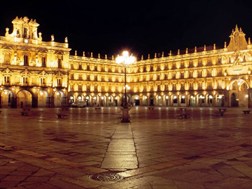Salamanca
 During the fifteenth century, Salamanca was divided by the growing rivalry between the noble families of the city, organized in the two opposing factions, the San Benito and Santo Tomé. An important centre for the production of textiles and exportation of wool, Salamanca joined the Comuneros revolt (1520) against the young King Charles to protest new taxes required by the sovereign to the parliament of the kingdom (the Cortes) and to protect the local textile manufacturers. Despite the defeat of the Comuneros, Salamanca enjoyed a period of great splendour in the sixteenth century, represented also by the prestige of its university. Plunged, as all of Castile, into a period of deep crisis during the seventeenth century, the city recovered in the next century, also assuming significant Baroque traits. The construction of its impressive Plaza Mayor (picture) dates back to 1729 while other monuments date back to the process of the rebuilding of the city after the damage caused by the earthquake of 1755.
During the fifteenth century, Salamanca was divided by the growing rivalry between the noble families of the city, organized in the two opposing factions, the San Benito and Santo Tomé. An important centre for the production of textiles and exportation of wool, Salamanca joined the Comuneros revolt (1520) against the young King Charles to protest new taxes required by the sovereign to the parliament of the kingdom (the Cortes) and to protect the local textile manufacturers. Despite the defeat of the Comuneros, Salamanca enjoyed a period of great splendour in the sixteenth century, represented also by the prestige of its university. Plunged, as all of Castile, into a period of deep crisis during the seventeenth century, the city recovered in the next century, also assuming significant Baroque traits. The construction of its impressive Plaza Mayor (picture) dates back to 1729 while other monuments date back to the process of the rebuilding of the city after the damage caused by the earthquake of 1755.
